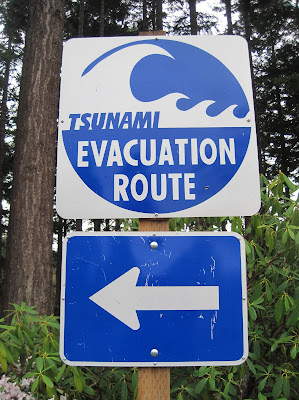It didn't start out bad. I considered my options and decided that I might as well visit Nisqually NWR. I had not visited the refuge in many years. It is much changed since I last visited and I was interested in taking a look.
The Nisqually NWR is on the delta of the Nisqually River. In the early 1900's this land was purchased and diked to make farmland. In this day and age such an alteration of a sensitive habitat would not likely take place. Information panels near the old historic barns reveal a series of trails and tribulations that the owners of this land faced.

For most of the last century the dikes have remained in place and the conversion of the property to a NWR created a large pond and marsh complex which was a haven for ducks. A 5 1/2 mile ring dike was a great way to tour the complex.
As a beginning birder I spent many hours here. This is the area I saw my first Great Horned Owl . I had many encounters with new birds I had not seen before. The complex of trees and water and open grassy areas supported many different habitats. I can remember one warm Spring visit where mosquitoes bit so viciously that I was swollen like I had mumps.

The refuge is still a wonderful place, but there has been a major change. The dikes have been intentionally breached, allowing salt water to once again return into the delta. This is a rare habitat in Puget Sound and vital for the health of the land and water life. Unique plants and animals live in these areas. Inter-tidal riparian areas are an important habitat for salmon, both early and late in life.
Now, instead of walking on the gravel tops of the dikes, elevated boardwalks are available where waters might come and go.

There are nice sitting spots which allow you to pause and wait for the wildlife around you to become active. I have seen otters, mink, beaver and long tailed weasels here.
There are always birds about and in the Spring it is best to arrive right at dawn. The swallows are fantastic since the marsh supports a lot of mosquito habitat as well. I even saw bugs of unknown species moving about today. No bites so not sure what they were. The migration return has not yet started. Today I got this nice picture of a Song Sparrow.

I had nice observation of a Great Blue Heron fishing.

I watched a Peregrine high in a tree preening and keeping careful watch on where its next meal was coming from.
Two juvenile Bald Eagles looked very wet and miserable in the rain. There were full adults further down the river. Now is the time for the start of nesting and I have to wonder if these two youngsters were soundly told to "leave home" so the parents could get on with a new years work.
I met with a volunteer far out on the dike where we enjoyed this view.

I asked him about the nest in the tree to the right of the barns.
He said that in 1997 the eagles built this nest but much of it blew down in a hard wind storm. Since then the eagles have nested to the west on the ridge bordering the margin of the refuge. That area gets less severe wind.
Since the eagles abandoned this nests, Canada Geese have used it. I was amazed at that idea but he said it was true. Two visitors observed a pair of geese honking and carrying on at the bottom of the tree. They looked up and sure enough, the young goslings jumped out of the nest and plummeted to the ground. Wood Duck nest in trees and the ducklings, once they are dry from hatching, launch themselves from the nest hole. They bounce a bit, get up and waddle away, no worse for wear. So it was for the geese. I cannot imagine the impact from that great height.
He mentioned that the Canadas use trees by the Education center. I did then remember that fact, I always thought it was odd. They are lower trees, not like the ones near the barn. He said that the geese of the delta are a closed, non-migrating population. I speculated that they had likely learned this nesting habit over time. The Bald Eagles have learned that the geese nest like this and there have been some easy pickings of setting birds
We talked further about the changes to the complex. He said the best time to come was during an extreme high tide. He said that the salt water fills this area pictured and comes to within two feet of the base of the dike.

I will keep my eye on the tide tables and repay a visit.























































